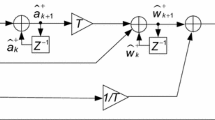Abstract
The equivalent bandwidth of a Kalman filter (KF) tracking loop for a Global Navigation Satellite System receiver is widely used to compare the performance of the KF with that of the traditional phase lock loop (PLL), but the existing literature does not adequately describe why they are comparable in terms of the equivalent bandwidth. The literature does neither address how the factors, including the line-of-sight (LOS) jerk, the local oscillator error, and the measurement noise, impact on the performance of the KF. Furthermore, there is no the rule-of-thumb threshold for the KF up to now. We prove that the steady KF is equivalent to a 3rd-order PLL in the sense of the minimum covariance in the continuous KF form, which makes it possible to compare the KF and the PLL loops in terms of the equivalent bandwidth. The factors that impact the performance of the KF are further investigated by error budgeting and suboptimal analysis. The analysis results show that the oscillator error, the LOS jerk, and the measurement error affect the steady KF error significantly while the initial state covariance has little effect on the convergence of the KF. A rule-of-thumb threshold for the KF, which is determined by the root mean squares of the loop thermal noise and the dynamic stress noise, is presented by analyzing the counterpart for the PLL. Four KF tracking loops are designed upon the proposed rule-of-thumb analysis, which are further validated by the Monte Carlo simulations.








Similar content being viewed by others
References
Brown RG, Hwang PYC (2012) Intermediate topics on Kalman filtering. Introduction to random signals and applied Kalman filtering, chapter 5, 4th edn. Wiley, New York, pp 184–187
Farrell JA (2008) Performance analysis. Aided navigation GPS with high rate sensors, chapter 6. Mc Graw Hill, New York, pp 217–234
Gelb A (1974) Optimal linear filtering. Applied optimal estimation, chapter 4. MIT Press, Cambridge, pp 136–141
Jaffe R, Rechtin E (1955) Design and performance of phase lock circuits capable of near-optimal performance over a wide range of input signal and noise levels. IRE Trans Inf Theory 1(1):66–76
Jin T, Wang YB, Lv WF (2013) Study of mean time to lose lock and lock detector threshold in GPS carrier tracking loops. Chin J Electron 22(1):46–50
Jwo DJ (2001) Optimisation and sensitivity analysis of GPS receiver tracking loops in dynamic environments. IEE Proc Radar Sonar Navig 148(4):241–250
O’Driscoll C, Lachapelle G (2009) Comparison of traditional and Kalman filter based tracking architectures. In: Proceedings of European Navigation Conference 2009, May, Naples, Italy, pp 1–10
O’Driscoll C, Petovello MG (2011) Choosing the coherent integration time for Kalman filter-based carrier-phase tracking of GNSS signals. GPS Solut 15(4):345–356
Patapoutine A (1999) On phase-locked loops and Kalman filters. IEEE Trans Commun 47(5):670–672
Petovello MG, Lachapelle G (2006) Comparison of vector-based software receiver implementations with application to ultra-tight GPS/INS integration. In: Proceedings of ION GNSS 2006, Institute of Navigation, September, Fort Worth TX, pp 1790–1799
Psiaki ML (2001a) Attitude sensing using a global-positioning-system antenna on a turntable. J Guid Control Dyn 24(3):474–481
Psiaki ML (2001) Smoother-based GPS signal tracking in a software receiver. In: Proceedings of ION GPS 2001, Institute of Navigation, September, Salt Lake City, UT, pp 2900–2913
Psiaki ML, Jung H (2002) Extended Kalman Filter Methods for Tracking Weak GPS Signals. Proc. ION GPS 2002, Institute of Navigation, September, Portland, OR, 2539-2553
Salem RD, O’Driscoll C, Lachapelle G (2012) Methodology for comparing two carrier phase tracking techniques. GPS Solut 16(2):197–207
Tang X, Falco G, Falletti E et al (2013) Practical implementation and performance assessment of an extended Kalman filter-based signal tracking loop. In: International conference on localization and GNSS. IEEE, pp 1–6
Tang XH, Falco G, Falleti E, Presti LL (2014) Theoretical analysis and tuning criteria of the Kalman filter-based tracking loop. GPS Solut 19(3):489–503
Van Dierendonck AJ (1996) GPS receivers In: Global positioning system: theory and applications, chap 8. American Institute of Astronautics and Aeronautics, pp 329–407
Ward PW (1997) Using a GPS receiver Monte Carlo simulator to predict RF interference performance. In: Proceedings of ION GPS 1997, Institute of Navigation, September, Kansas City, pp 1473–1482
Ward PW (1998) Performance comparisons between FLL, PLL and a novel FLL-assisted-PLL carrier tracking loop under RF interference conditions. In: Proceedings of ION GPS 1998, Institute of Navigation, September, Nashville, USA, pp 783–795
Ward PW, Betz JW, Hegarty CJ (2006) Satellite signal acquisition, tracking and data demodulation. In: Kaplan ED, Hegarty CJ (eds) Understanding GPS, chap 5, 2nd edn. Artech House, Boston, pp 153–241
Won JH, Eissfeller B (2013) A tuning methods based on signal-to-noise power ratio for adaptive PLL and its relationship with equivalent noise bandwidth. IEEE Commun Lett 17(2):393–396
Won JH, Dotterbock D, Eissfeller B (2009) Performance comparison of different forms of Kalman filter approach for a vector-based GNSS signal tracking loop. In: Proceedings of ION GNSS 2009, Institute of Navigation, September, Savannah, GA, pp 3037–3048
Won JH, Pany T, Eissfeller B (2012) Characteristics of Kalman filters for GNSS signal tracking loop. IEEE Trans Aerosp Electron Syst 48(4):3671–3681
Ziedan NI, Garrison JL (2003) Bit synchronization and Doppler frequency removal at very low carrier to noise ratio using a combination of the Viterbi algorithm with an extended Kalman filter. In: Proceedings of ION GPS 2003, Institute of Navigation, September, Portland, OR, pp 616–627
Author information
Authors and Affiliations
Corresponding author
Rights and permissions
About this article
Cite this article
Jiang, R., Wang, K., Liu, S. et al. Performance analysis of a Kalman filter carrier phase tracking loop. GPS Solut 21, 551–559 (2017). https://doi.org/10.1007/s10291-016-0546-9
Received:
Accepted:
Published:
Issue Date:
DOI: https://doi.org/10.1007/s10291-016-0546-9




